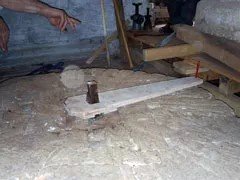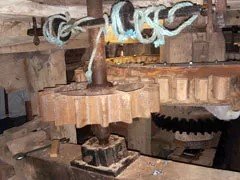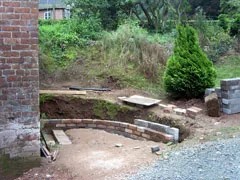Best viewed in landscape
Watermill Blog - Using a Trammel
28th August 2008
What is a trammel and why the excitement? The picture shows the old trammel that we found in place on the stone spindle.

We used it to check that the spindle was perpendicular to the bed stone, an important step before we try to run the top stone with the waterwheel. Running the stones will be an enormous step forward, hence the anticipation and excitement.
We couldn't find a goose feather quill, the traditional thing to use, so we pushed a pencil through the hole in the outer end of the trammel and slowly turned the spindle. By listening to tell when the pencil touched the bed stone we could work out which way to adjust the bottom bearing of the stone spindle to get the it just so.
Of course, this meant we had to have removed the runner stone first. Dave and Richard had tackled this, helped in the final stages by Martyn and Colin. After all, a 48 inch diameter millstone weighs the better part of a ton.

Before they were drafted in as muscle, Martyn and Colin had been busy fitting more wooden cogs to the great spur gear. Once these are all in place we will be able to try running a stone, gently!
The picture on the right shows the stone nut in mesh with the cogs on the great spur gear.
The picture also shows the bottom bearing of the stone spindle and two adjusting screws can be seen sticking out at the sides of the block. There are two more out of sight, of course.
Outside the mill, the rest of the team got on with on-going tasks. Derek cleared the landscaping of the remains of the ivy from the fence over the end of the culvert while Bob and Dick worked on the area at the bottom of the side steps, smoothing the ground and spreading chippings.

The old gatepost by the end of the culvert was made from two railway sleepers on end and one of them had rotted to a shell. The rotten one was removed, but the other is still sound so we have left it as it is.
John and Jonathan worked together again on the retaining wall outside the bottom door of the mill.
When this wall is complete we are going to dig a channel against the mill wall and fill it with gravel, as well as filling the gap behind the retaining wall. The drain created will be directed into the culvert which passes close underneath the end of the wall.
We hope this will drain rain and ground water away from the mill and reduce the damp penetration of the north wall.
Plans from the mid 19th Century show some kind of extension, probably a lean to, on this side of the mill that would have protected the basement from damp on this side at least. The only trace remaining is a timber wall plate and a projecting course of brick above it that probably marks the roof line.
With all the excitement, including some generous visitors around lunchtime, it was past 5 o'clock before the last of the team headed for home, locking up after themselves.
Go to the next Watermill Blog entry
Go to the previous Watermill Blog entry
Learn how to support us
Return to our Home Page